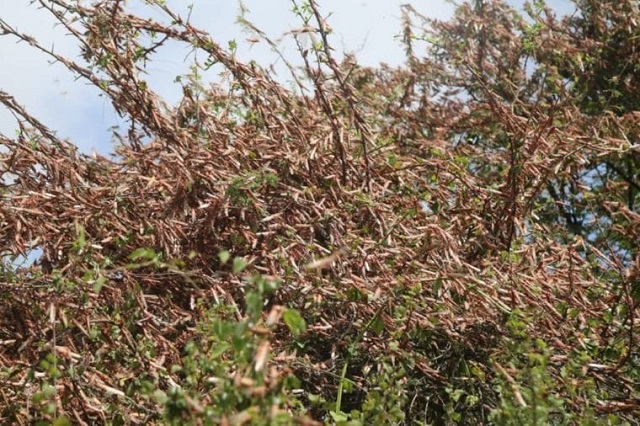
Kampala, Uganda | THE INDEPENDENT | Residents and leaders in northern Uganda are anxious over the possible invasion of crop-devouring desert locusts that have devastated parts of Kenya, Somalia and Ethiopia.
The swarms with unprecedented size and destructive potential have destroyed hundreds of thousands of acres of crops, posing a bigger threat of food insecurity across the East African region. They have so far been detected in six counties of Kenya that includes Wajir, Isiolo, Mandera, Marsabit, Garissa, and Meru.
Food and Agriculture Organisation said that although Uganda and South Sudan are not currently affected, they are at high risk because they equally have favourable conditions for the rapid reproduction of the locusts. It added that if left unchecked, the numbers of crop-devouring insects could grow 500 fold by June 2020.
The UN agency added that the locusts now wandering into Turkana county, pose threats of a likely spill over into Karamoja sub-region in North-Eastern Uganda, which also shares a common boundary with Acholi, Lango and Teso sub-regions.
Martin Owor, the Commissioner Disaster Preparedness confirms a likely potential and risk of a locust invasion into Karamoja where the risk of further spread inland to Acholi sub-region cannot be ruled out. It’s for this reason that many residents in northern Uganda are living in uncertainty.
Felix Onencan, a commercial farmer in Nwoya district says that news about the invasion in Kenya and the possible spillover into Uganda, is scary, especially for the farmers. Pader district chairperson Godfrey Largro Oringa says that a week ago, a mere sight of grasshoppers along the Aswa River sent residents into a panic, as many thought that the locusts had arrived.
Largo observes that the district is not in any way prepared to face such disastrous invasion of locusts if they spill over into Pader given its proximity to Karamoja, the region on the spotlight over a likely infiltration.
Meanwhile, Brenda Atim, a concerned farmer in Gulu expressed uncertainty about food security and livelihoods situation should the locusts migrate further inland to Uganda and appealed to the line Ministries to sensitize the masses.
FAO warns that locusts can multiply quickly, forming highly mobile groups and swarms which are made up of millions of locusts – can eat up to 100,000 tons of green vegetation per day and can cause massive famine and starvation.
FAO adds that the swarms potentially containing hundreds of millions of individual desert locusts can move 150 kilometres a day – devastating rural livelihoods. During plagues, desert locusts can easily affect 20 percent of the Earth’s land, more than 65 of the world’s poorest countries, and potentially damage the livelihood of one-tenth of the world’s population.
Recently, Uganda announced that it needed up to five billion Shillings to support both pest control and livelihood protection operations in the country should the migratory locusts invade some parts of the country.
*****
URN
 The Independent Uganda: You get the Truth we Pay the Price
The Independent Uganda: You get the Truth we Pay the Price


